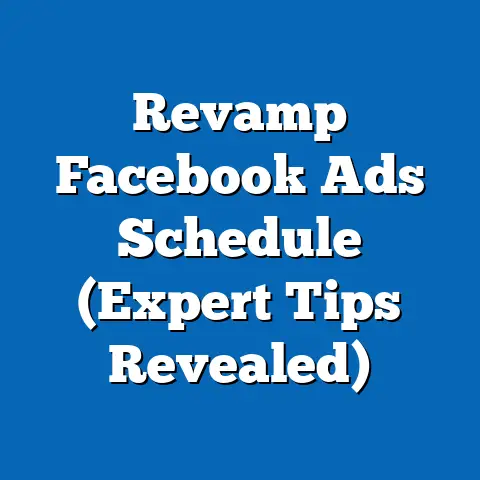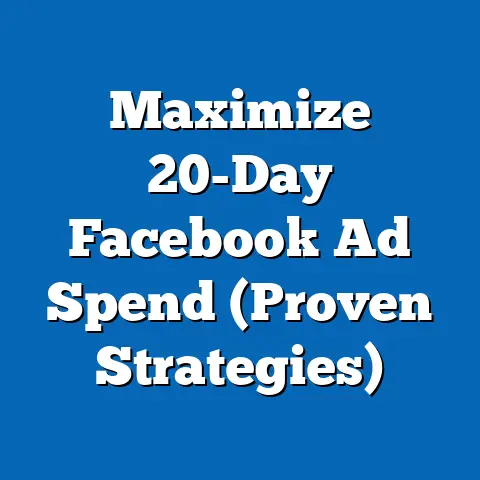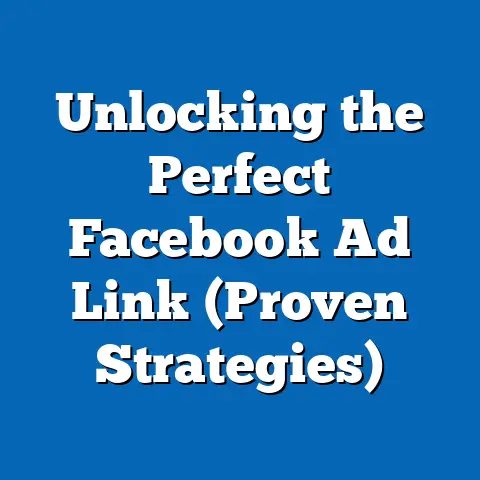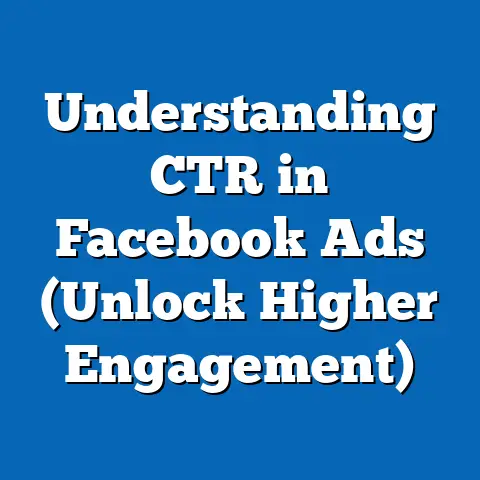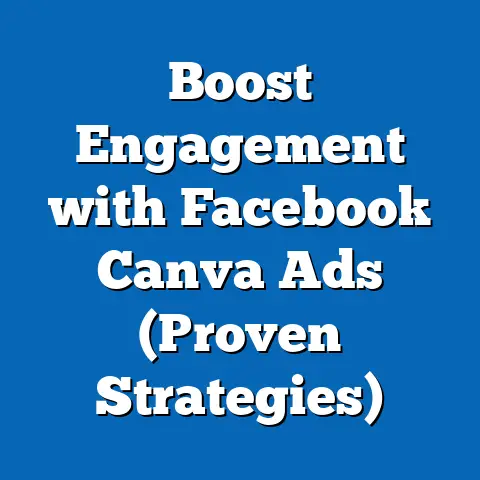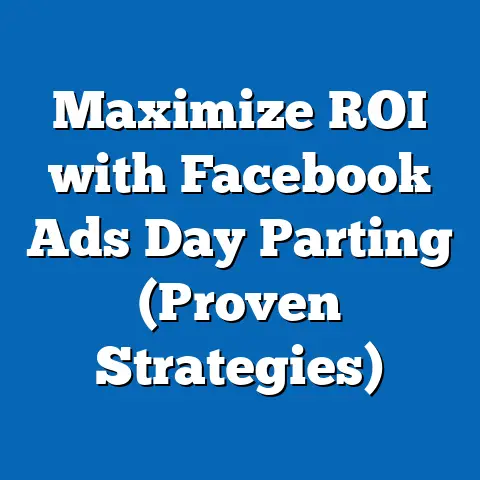Unlock Facebook Ad Bots (Transformative Strategies Revealed)
The future of digital marketing is here, and it’s powered by artificial intelligence. As someone who’s been in the trenches of online advertising for years, I’ve witnessed firsthand the incredible evolution of Facebook advertising. From simple boosted posts to complex, multi-layered campaigns, the platform has constantly adapted to meet the ever-changing demands of consumers. Now, we’re entering a new era, one where Facebook ad bots are not just a futuristic concept, but a tangible tool that can revolutionize your marketing efforts.
Think of it: AI-powered assistants working tirelessly to optimize your campaigns, predict user behavior, and deliver personalized experiences at scale. It sounds like something out of a science fiction movie, but it’s becoming a reality. The key to staying competitive in today’s digital landscape lies in embracing these technological advancements. Facebook ad bots streamline processes, optimize campaigns, and enhance user engagement in ways that were previously unimaginable.
This article is your guide to navigating this exciting new world. I’ll break down what Facebook ad bots are, how they work, and, most importantly, how you can leverage them to achieve transformative results. Get ready to unlock the power of automation and take your Facebook advertising to the next level. The future of advertising is intelligent, and it’s time to get on board.
Understanding Facebook Ad Bots
What Are Facebook Ad Bots?
When I talk about Facebook ad bots, I’m referring to software programs designed to automate and optimize various aspects of Facebook advertising campaigns. They leverage machine learning algorithms and artificial intelligence to analyze data, predict user behavior, and make real-time adjustments to ad placements, targeting, and content. Essentially, they act as your 24/7 advertising assistants, constantly working to improve your campaign performance.
These bots aren’t just about automating simple tasks; they’re about making data-driven decisions at scale. They can analyze vast amounts of data – things like user demographics, interests, behaviors, and past interactions with your ads – to identify patterns and insights that would be impossible for a human to uncover manually.
The Technology Behind Ad Bots
The heart of Facebook ad bots lies in their sophisticated technology. They rely on several key components:
- Machine Learning (ML): ML algorithms allow the bots to learn from data and improve their performance over time. For example, a bot might analyze the performance of different ad creatives and learn which ones resonate most with specific audiences.
- Artificial Intelligence (AI): AI enables bots to perform complex tasks such as natural language processing (NLP) for understanding user sentiments and computer vision for analyzing images and videos.
- Data Analytics: Bots use data analytics tools to process and interpret large datasets, identifying trends and patterns that inform advertising decisions.
- Automation: Automation tools allow bots to execute tasks such as ad creation, bidding, and reporting without human intervention.
How Ad Bots Predict User Behavior
One of the most powerful capabilities of Facebook ad bots is their ability to predict user behavior. By analyzing historical data, bots can identify users who are most likely to be interested in your products or services. They can also predict when users are most likely to engage with your ads and what types of content they prefer.
For example, a bot might identify users who have recently searched for keywords related to your products, visited your website, or interacted with your competitors’ ads. It can then target these users with personalized ads that are tailored to their specific interests and needs.
Real-World Examples of Ad Bot Integration
I’ve seen many businesses successfully integrate Facebook ad bots into their marketing strategies. Here are a few examples:
- E-commerce: An online retailer uses ad bots to automatically generate personalized product recommendations for each user based on their browsing history and past purchases. This has led to a significant increase in conversion rates and average order value.
- Lead Generation: A B2B company uses ad bots to identify and target potential leads with relevant content offers. The bots analyze user demographics, job titles, and company sizes to ensure that the right content is delivered to the right people.
- App Installs: A mobile app developer uses ad bots to optimize their app install campaigns. The bots automatically adjust bidding strategies and targeting parameters based on real-time performance data, resulting in a lower cost per install.
Takeaway: Facebook ad bots are powerful tools that can automate and optimize various aspects of your advertising campaigns. They leverage machine learning, artificial intelligence, and data analytics to predict user behavior and deliver personalized experiences at scale.
Key Transformative Strategies for Leveraging Facebook Ad Bots
Now that we’ve established what Facebook ad bots are, let’s dive into the transformative strategies you can use to leverage their power. I’ve seen these strategies work time and time again, and I’m confident they can help you achieve significant results.
Strategy 1: Automated Targeting and Segmentation
Reaching the Right Audience
One of the biggest challenges in Facebook advertising is identifying and targeting the right audience. With so many users on the platform, it’s easy to waste money on ads that are shown to people who are unlikely to be interested in your products or services.
Facebook ad bots can automate this process by analyzing vast amounts of data to identify the most promising target audiences. They can segment users based on demographics, interests, behaviors, and past interactions with your ads.
Data-Driven Insights
The implications of using data-driven insights for targeting are profound. You can:
- Increase Conversion Rates: By targeting users who are most likely to be interested in your products or services, you can significantly increase your conversion rates.
- Reduce Ad Spend: By focusing your ad spend on the most promising target audiences, you can reduce waste and improve your ROI.
- Improve Ad Relevance: By delivering ads that are relevant to users’ interests and needs, you can improve engagement and brand perception.
Example: Imagine you’re selling running shoes. An ad bot could identify users who have recently purchased running shoes from other retailers, joined running groups on Facebook, or expressed interest in marathon events. You can then target these users with ads that showcase your latest running shoe models and highlight their performance benefits.
Strategy 2: Dynamic Ad Creation
Personalized Ad Content
In today’s world, generic ads simply don’t cut it. Users expect personalized experiences that are tailored to their specific interests and needs. Facebook ad bots can help you deliver this level of personalization through dynamic ad creation.
Dynamic ads are personalized ad content that is generated in real-time based on user interactions and preferences. They can automatically adjust the ad copy, images, and call-to-action based on factors such as the user’s location, browsing history, and past purchases.
Improved Engagement
Dynamic ad creation can lead to significant improvements in engagement. By delivering ads that are relevant and personalized, you can:
- Increase Click-Through Rates (CTR): Users are more likely to click on ads that are relevant to their interests.
- Improve Conversion Rates: Users are more likely to convert when they see ads that are tailored to their specific needs.
- Enhance Brand Perception: Users appreciate brands that take the time to understand their needs and deliver personalized experiences.
Example: Let’s say you’re running an e-commerce store that sells clothing. With dynamic ad creation, you can show users ads for products they’ve recently viewed on your website. You can also show them ads for products that are similar to those they’ve purchased in the past. This level of personalization can significantly increase the likelihood of a sale.
Strategy 3: Performance Monitoring and Optimization
Continuous Monitoring
One of the most time-consuming aspects of Facebook advertising is monitoring ad performance and making adjustments to optimize results. Fortunately, Facebook ad bots can automate this process.
These bots continuously monitor ad performance, tracking metrics such as impressions, clicks, conversions, and cost per acquisition (CPA). They can then make adjustments to bidding strategies, targeting parameters, and ad creatives to improve performance.
On-the-Fly Adjustments
By making adjustments on-the-fly, ad bots can ensure that your campaigns are always performing at their best. They can:
- Identify Underperforming Ads: Bots can quickly identify ads that are not performing well and pause them to prevent further waste.
- Optimize Bidding Strategies: Bots can automatically adjust bidding strategies to maximize conversions and minimize CPA.
- Test New Ad Creatives: Bots can run A/B tests to identify the most effective ad creatives and automatically scale up the winning variations.
Key Metrics
When assessing the effectiveness of your campaigns, focus on these metrics:
- Click-Through Rate (CTR): Measures the percentage of users who click on your ads.
- Conversion Rate: Measures the percentage of users who complete a desired action, such as making a purchase or filling out a form.
- Cost Per Acquisition (CPA): Measures the cost of acquiring a new customer or lead.
- Return on Ad Spend (ROAS): Measures the revenue generated for every dollar spent on advertising.
Example: Imagine you’re running a campaign to promote a new product launch. An ad bot could continuously monitor the campaign’s performance and make adjustments to the bidding strategy based on real-time data. If the bot detects that the CPA is too high, it can automatically lower the bids or adjust the targeting parameters to improve efficiency.
Strategy 4: Budget Management and Cost Efficiency
Intelligent Budget Management
Managing your Facebook advertising budget effectively is crucial for achieving your marketing goals. However, it can be challenging to allocate funds optimally, especially when you’re running multiple campaigns with different objectives.
Facebook ad bots can manage your budget intelligently, reallocating funds to high-performing ads and campaigns. They can analyze performance data to identify which ads are generating the best ROI and automatically increase their budgets.
Better ROI and Cost Savings
This strategy can lead to significant improvements in ROI and cost savings. By focusing your budget on the most effective ads, you can:
- Maximize Conversions: By allocating more funds to high-performing ads, you can maximize the number of conversions you generate.
- Reduce Waste: By reducing the budget for underperforming ads, you can prevent unnecessary waste.
- Improve Overall ROI: By optimizing your budget allocation, you can improve the overall ROI of your Facebook advertising campaigns.
Example: Let’s say you’re running two campaigns: one to promote a specific product and another to generate leads for your business. An ad bot could analyze the performance of each campaign and determine that the product campaign is generating a higher ROI. The bot can then automatically reallocate funds from the lead generation campaign to the product campaign, maximizing your overall return.
Takeaway: Leveraging Facebook ad bots can transform your advertising strategies by automating targeting, creating dynamic ads, monitoring performance, and managing budgets intelligently. These strategies can lead to significant improvements in engagement, conversion rates, and ROI.
Overcoming Challenges in Implementing Facebook Ad Bots
While the potential benefits of Facebook ad bots are undeniable, it’s important to acknowledge the challenges that businesses may face when integrating them into their existing marketing strategies. I’ve seen these challenges firsthand, and I want to share some insights on how to overcome them.
Data Privacy Concerns
One of the biggest concerns surrounding ad bots is data privacy. These bots rely on vast amounts of user data to make decisions, which raises questions about how this data is collected, stored, and used.
Solution: Be transparent with your users about how you’re using their data. Comply with all relevant data privacy regulations, such as GDPR and CCPA. Implement robust security measures to protect user data from unauthorized access.
Bot Reliability
Another challenge is ensuring the reliability of ad bots. These bots are complex software programs that can sometimes malfunction or make errors.
Solution: Choose reputable ad bot providers with a proven track record. Regularly monitor the performance of your ad bots and address any issues promptly. Implement backup systems to minimize the impact of potential failures.
Learning Curve
There’s also a learning curve associated with using ad bots. These tools can be complex and require specialized knowledge to operate effectively.
Solution: Invest in training for your marketing team. Provide them with the resources they need to learn how to use ad bots effectively. Consider hiring experts who can help you implement and manage your ad bot strategies.
Takeaway: Implementing Facebook ad bots comes with challenges such as data privacy concerns, bot reliability, and a learning curve. Addressing these challenges through strategic planning, transparency, and ongoing training can help you successfully integrate ad bots into your marketing strategies.
Future Trends in Facebook Advertising with AI and Bots
The future of Facebook advertising is inextricably linked to artificial intelligence and bots. As these technologies continue to evolve, they will unlock new possibilities for marketers. Let’s speculate on some of the trends we can expect to see in the coming years.
Advanced Predictive Analytics
AI will become even better at predicting user behavior. This will enable marketers to target users with even greater precision and deliver more personalized experiences.
Enhanced Personalization
AI will enable marketers to create truly personalized ads that are tailored to the individual user’s interests, needs, and preferences.
Integration of AR/VR Technologies
Augmented reality (AR) and virtual reality (VR) technologies will be integrated into Facebook ads, creating immersive and engaging experiences for users.
Takeaway: Staying ahead of future trends in Facebook advertising with AI and bots can empower businesses to maintain a competitive edge. Innovations such as advanced predictive analytics, enhanced personalization, and the integration of AR/VR technologies in ads will shape the future of digital marketing.
Conclusion
The transformative potential of Facebook ad bots in modern advertising is undeniable. Throughout this article, I’ve outlined key strategies for leveraging these technologies, including automated targeting and segmentation, dynamic ad creation, performance monitoring and optimization, and budget management. While challenges such as data privacy concerns and the learning curve exist, strategic planning and ongoing training can help businesses overcome these hurdles.
As digital marketing continues to evolve, embracing AI and ad bots will be essential for future success. By staying informed about emerging trends and adapting to the latest technologies, businesses can unlock new opportunities and maintain a competitive edge. The future of advertising is intelligent, and I encourage you to embrace these technologies and explore the exciting possibilities that lie ahead.

